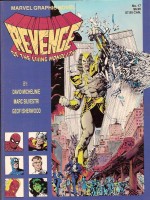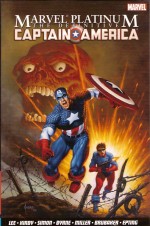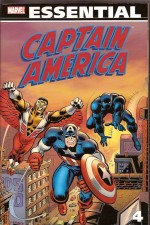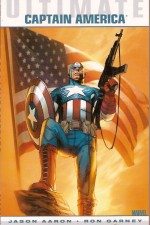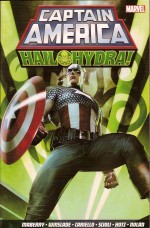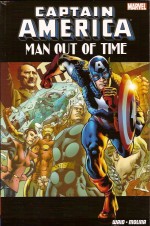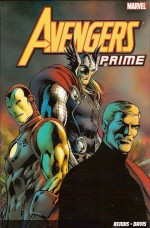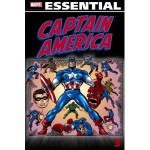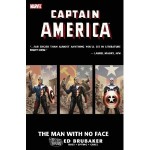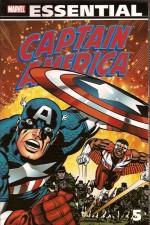
By Jack Kirby, Frank Robbins, Frank Giacoia & various (Marvel)
ISBN: 978-0-7851-4535-6
Created by Joe Simon & Jack Kirby in an era of frantic patriotic fervour, Captain America was a dynamic and highly visible response to the horrors of Nazism and the threat of Liberty’s loss. He faded during the post-war reconstruction but briefly reappeared after the Korean War: a harder, darker sentinel ferreting out monsters, subversives and the “commies†who lurked under every American bed. Then he vanished once more until the burgeoning Marvel Age resurrected him just in time to experience turbulent, culturally divisive 1960s.
This fifth Essential collection features the spectacular return of “The Kingâ€, as Jack Kirby took over writing, drawing and editing the Sentinel of Liberty in the year of the country’s two hundredth birthday. This stunning black and white compendium reprints issues #187-205 (July 1975-January 1977) of the monthly comicbook and includes Captain America Annual #3 and the magnificent commemorative tabloid Captain America’s Bicentennial Battles.
At the end of the previous volume the Red Skull had returned in all his gory glory and, after a staggeringly effective campaign of terror, revealed that the high-flying Falcon had been his unwitting secret weapon for years: a cheap gangster named Sam “Snap†Wilson reprogrammed by the Cosmic Cube into the perfect partner for Captain America and a tantalising, ticking time bomb waiting to explode…
Captain America and the Falcon #187 opens the show here with ‘The Madness Maze!’ (by John Warner, Frank Robbins & Frank Chiaramonte) with the Skull fled and the now-comatose Falcon in the custody of super-spy agency S.H.I.E.L.D. Suddenly the Star-Spangled Avenger was abducted by a mysterious flying saucer and attacked by alchemical androids employed by a rival espionage outfit , culminating in a ‘Druid-War’ (Warner, Sal Buscema & Vince Colletta), before Tony Isabella, Robbins & Chiaramonte put Cap into an ‘Arena For a Fallen Hero!’ where psychological warfare and unarmed combat combined into a radical therapy to kill or cure the mind-locked sidekick.
Just as the radical cure kicked in an old foe took over S.H.I.E.L.D.’s flying HQ in ‘Nightshade is Deadlier the Second Time Around!’ (Isabella, Robbins & Colletta), after which the crimes of forcibly-reformed Snap Wilson were examined and judged in the climactic wrap-up ‘The Trial of the Falcon!’ (Isabella, Bill Mantlo, Robbins & D. Bruce Berry) with a predictable court ruling, a clutch of heroic cameos and a bombastic battle against the sinister Stilt-Man.
With the narrative decks cleared, Captain America and the Falcon #192 featured an ingenious, entertaining filler written by outgoing editor Marv Wolfman, illustrated by Robbins & Berry, wherein Cap hopped on to a commercial plane and found himself battling Dr. Faustus and a contingent of gang-bosses on a ‘Mad-Flight!’ thousands of feet above New York.
In 1976 Kirby exploded back into the Marvel Universe with a slew of new creations (2001: a Space Odyssey, Machine Man, The Eternals, Devil Dinosaur) and assumed control of established characters Captain America and latterly the Black Panther. His return was much hyped at the time but swiftly became controversial. His new work quickly found friends, but his tenure on his earlier inventions divided the fan base.
Kirby was never slavishly wedded to tight continuity and preferred, in many ways, to treat his stints on Cap and the Panther as a kind of creative “Day Oneâ€.
Captain America Annual #3 was a feature- length science fiction shocker which eschewed the convoluted back-story and cultural soul searching of the recent past and simply confronted the valiant hero with a cosmic vampire in ‘The Thing From the Black Hole Star!’; a riot of rampaging action and end-of-the-world wonderment featuring a fallible but fiercely determined fighting man free of doubt and determined to defend the world at all costs…
Kirby had big plans for the nation’s premiere comicbook patriotic symbol. Captain America’s Bicentennial Battles was released to commemorate the USA’s two hundredth year in Marvel’s tabloid Treasury Format (80+ pages of 338 x 258mm dimensions) and featured the Sentinel of Liberty on an incredible excursion through the key eras and areas of American history.
A vast, expansive, panoramic and iconic celebration of the memory and the myth of the nation, this almost abstracted and heavily symbolic 84 page extravaganza perfectly survives the surrender of colour and reduction to standard comic dimensions, following Captain America when cosmic savant Mister Buda propelled the querulous Avenger into successive significant segments of history: encountering lost partner Bucky during WWII, meeting Benjamin Franklin in Revolutionary Philadelphia and revisiting the mobster-ridden depression era of Steve Roger’s childhood.
Cap met Geronimo during the Indian Wars, suffered the horrors of a mine cave-in, survived a dogfight with a German WWI fighter ace, battled bare-knuckle boxer John L. Sullivan, resisted slavers with abolitionist John Brown, observed the detonation of the first Atom Bomb, saw the great Chicago Fire and even slipped into America’s future…
He experienced the glory days of Hollywood, the simple joys of rural homesteading and the harshest modern ghetto, before drawing strength from the nation’s hopeful children…
Inked by such luminaries as Barry Windsor-Smith, John Romita Sr. and Herb Trimpe the book-length bonanza is peppered with a glorious selection of pulsating pin-ups.
After absorbing the worth of a nation Captain America and the Falcon #193 concentrated on saving it with the opening salvo in an epic storyline leading up the immortal super-soldier’s own 200th issue.
Inked by fellow veteran Frank Giacoia ‘The Madbomb’ revealed a ‘Screamer in the Brain!’ when a tiny new weapon was triggered by unknown terrorists, reducing an entire city block to rubble by driving the populace into a mass psychotic frenzy. Experiencing the madness at close hand Cap and the Falcon were seconded by the government to find the culprits and the full scale device hidden somewhere in America…
‘The Trojan Horde’ introduced plutocratic mastermind William Taurey who intended to unmake the American Revolution and restore an aristocracy. Using inestimable wealth, a cadre of similarly disgruntled millionaire elitists, an army of mercenaries, slaves transformed into genetic freaks and other cutting edge super-science atrocities, the maniac intended to forever destroy the Republic.
Moreover, when he was in charge, the first thing Taurey intended was to hunt down the last descendent of Colonial hero Steven Rogers, who had killed Taurey’s Monarchist ancestor and allowed Washington to win the War of Independence.
Little did he suspect the subject of his wrath had already infiltrated his secret army…
In ‘It’s 1984!’ (inked by D. Bruce Berry) Cap and Falcon got a first-hand look at the kind of world Taurey advocated, battling their way through monsters, mercenaries and a mob fuelled by modern mind-control and Bread and Circuses, before ultra-spoiled elitist Cheer Chadwick took then under her bored and privileged wing…
Even she couldn’t keep her new pets from being sucked into the bloody, brutal Circus section of the New Society as the heroes were forced to fight for their lives in ‘Kill-Derby’ and as the US army raided the secret base in ‘The Rocks are Burning!’ (Giacoia inks) the heroes realised it was all for nought since the colossal Mad-Bomb was still active and lost somewhere in their vast Home of the Brave.
The offbeat ‘Captain America’s Love Story’ took a decidedly different and desperate track as the Bastion of Freedom was forced to romance a sick woman to get to her father – who had invented the deadly device – after which ‘The Man Who Sold the United States’ returned to all-out action as the Cap and Falcon raced a countdown to national disaster as the Bomb was finally triggered by ‘Dawn’s Early Light!’ in a spectacular showdown climax which surpassed every expectation.
With Captain America and the Falcon #201, the pace shifted to malevolent moodiness and uncanny mystery with ‘The Night People!’: a street-full of mutants and maniacs who periodically phased into and out of New York City, creating terror and chaos every evening. When Falcon and Leila were abducted by the eerie encroachers there were soon converted to their crazed cause by the ‘Mad, Mad Dimension!’ they inhabited during daylight hours, leaving Captain America and new associate Texas Jack Muldoon hopelessly outgunned when their last-ditch rescue attempt left them all battling an invasion of berserkers beasts in ‘Alamo II!’
On bludgeoning, bombastic top-form, the Star-Spangled Avenger saved the day once more, but no sooner were the erstwhile inhabitants of Zero Street safely ensconced on Earth than ‘The Unburied One!’ pitted the indefatigable champions against a corpse which wouldn’t play dead. The concluding chapter and last tale in this blockbusting tome revealed the cadaver had become home to an energy being from the far future when ‘Agron Walks the Earth!’ but not even its blistering power and rage could long baulk the indomitable spirit and ability of America’s Ultimate Fighting Man.
This supremely thrilling collection also has room for a selection of Kirby cover roughs and un-inked pencils that will delight art fans and aficionados. The King’s commitment to wholesome adventure, breakneck action and breathless wonderment, combined with his absolute mastery of the comic page and unceasing quest for the Next Big Thrill, always make for a captivating read and this stuff is as good as any of his post Fourth World stuff.
However, it does make this book a bit of a double-edged treat. Engaging and impressive as the first half-dozen stories in this volume are, they are worlds away in style, form and content from the perfect imaginative maelstrom of Kirby at his creative peak.
Not better but very, very different.
You can hate one and love the other, but perhaps it’s better to try to appreciate each era on its own merits…
Fast-paced, action-packed, totally engrossing fights ‘n’ tights masterpieces no fan should ignore and above all else, fabulously fun tales of a true American Dream…
© 1972, 1973, 1984, 1975, 2005 Marvel Characters, Inc. All rights reserved.

